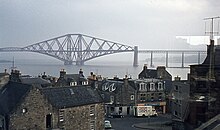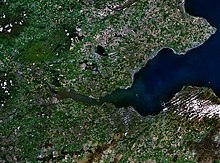Firth of Forth







The Firth of Forth is the estuary or firth of Scotland's River Forth, where it flows into the North Sea, between Fife to the north, and West Lothian, the City of Edinburgh and East Lothian to the south. It was known as Bodotria in Roman times.
Geography and economy
Geologically, the Firth of Forth is a fjord, formed by the Forth Glacier in the last glacial period.
There are many towns which line the shores, as well as the petrochemical complexes at Grangemouth, the commercial docks at Leith, former oilrig construction yards at Methil, the ship-breaking facility at Inverkeithing and the naval dockyard at Rosyth, with numerous other industrial areas including the Forth Bridgehead area (i.e., Rosyth, Inverkeithing and the southern edge of Dunfermline), Burntisland, Kirkcaldy, Bo'ness and Leven.
The Kincardine Bridge and the Forth Road Bridge and Forth Bridge carry traffic across the firth. A fourth crossing, located next to the Kincardine Bridge, opened in 2008. On 1 October 2008 it was announced that the new bridge would be called the Clackmannanshire Bridge.[1] Queensferry Crossing, another new road bridge is under construction alongside the Forth Road Bridge and is expected to be open in 2016.[2]
In July 2007, a hovercraft passenger service completed a two-week trial between Portobello, Edinburgh and Kirkcaldy, Fife. The trial of the service (marketed as "Forthfast") was hailed as a major operational success, with an average passenger load of 85%.[3] It was estimated the service could cut congestion for commuters on the Forth road and rail bridges by carrying about 870,000 passengers a year.[4] The plans were shelved in December 2011.
The inner firth, i.e. between the Kincardine and Forth bridges, has lost about half of its former intertidal area as a result of land being reclaimed, partly for agriculture, but mainly for industry and the large ash lagoons built to deposit the spoil from the coal fired Longannet Power Station near Kincardine. Historic villages line the Fife shoreline; Limekilns, Charlestown and the 6th century established Culross, where Saint Kentigern was born.
The firth is important for nature conservation and a Site of Special Scientific Interest. The Firth of Forth Islands SPA (Special Protection Area) is host to over 90,000 breeding seabirds every year. There is a bird observatory on the Isle of May.
In 2008, a controversial bid to allow oil transfer between ships in the firth was refused by Forth Ports. A company named SPT Marine Services had asked permission to transfer 7.8 million tonnes of crude oil per year between tankers. The proposals had met with determined opposition from conservation groups.[5]
Firth of Forth islands
- Bass Rock
- Craigleith
- Cramond
- Eyebroughy
- Fidra
- Inchcolm
- Inchgarvie
- Inchkeith
- Inchmickery with Cow and Calf
- The Lamb
- Isle of May
Settlements on the shoreline
- North Shore
- South Shore
Places of interest
- Aberlady Bay, Archerfield Links
- Barns Ness Lighthouse, Belhaven, Berwick Law, Blackness Castle
- Cockenzie Power Station, Culross
- Dalmeny House, Dirleton Castle
- Fa'side Castle
- Gullane Bents
- Hopetoun House, Hopetoun Monument
- John Muir Country Park, John Muir Way
- Longniddry Bents
- Musselburgh Racecourse
- North Berwick Golf Club
- Prestongrange Industrial Heritage Museum, Preston Tower
- Ravenscraig Castle
- Scottish Fisheries Museum, Scottish Seabird Centre
- Seton Sands
- St. Fillan's Cave
- St. Monans Windmill
- Tantallon Castle, Torness Nuclear Power Station
- Waterston House
References
- ^ BBC news report, 1 October 2008
- ^ "New Forth bridge: Queensferry Crossing wins naming contest". BBC News. 26 June 2013.
- ^ "Kirkcaldy-Edinburgh hovercraft trial". The Scottish Executive. 13 July 2007. Retrieved 10 January 2010.
- ^ "Plans lodged for Forth hovercraft". Edinburgh Evening News. 7 January 2010. Retrieved 10 January 2010.
- ^ "Forth oil transfer plan ruled out". BBC News Online. 1 February 2008. Retrieved 1 February 2008.
External links
- Isle of May bird observatory
- Forthfast experimental hovercraft service, 16–28 July 2007
- Inchcolm Virtual Tour Take a virtual tour around some of the Inchcolm's military defences
- [1] fdsa
- Use dmy dates from May 2013
- Firth of Forth
- Firths of Scotland
- Ramsar sites in Scotland
- Sites of Special Scientific Interest in Dunfermline and Kirkcaldy
- Sites of Special Scientific Interest in Edinburgh and West Lothian
- Sites of Special Scientific Interest in Falkirk and Clackmannan
- Sites of Special Scientific Interest in Mid and East Lothian
- Sites of Special Scientific Interest in North East Fife
- North Sea
